Understanding Multi-touch Attribution Models

Our customers engage with our brand across multiple channels throughout their “buyer’s journey” before they convert. This is intentional!
As marketers, we know that multi-channel campaigns are the best way to ensure we’re reaching our audience in the right places at the right times and influencing them as they move through their journey from awareness to conversion.
But when it comes to tracking the success of your multi-channel campaign, running reports in silo like web traffic or email performance reports won’t cut it. You know just as well as I that your reports need to take into consideration your multi-channel approach in order to provide the best picture of your campaign’s success. Thank the marketing gods (and great technology) for multi-channel attribution reports!
Multi-touch attribution reports measure and assign value to all of the interactions a contact takes up to a key moment in their journey (whether that be a visit to your site, a contact added to your CRM, a lead converting, or a deal closing.)
Multi-touch attribution reports help us:
- Accurately credit marketing activities in a campaign with ROI
- Predict the impact of an increase or decrease in campaign spend
- Predict the impact of adding or removing a channel from your campaign
- Gain visibility into which channel (and which combination of channels) are bringing in the “best” (best quality traffic, best leads, best customers, best testimonials…)
- Prove the ROI of an entire campaign
- And so on…
Sounds great right? Let’s take a look at the different models so you can decide which is best for your marketing strategy.
A Few Things to Note on Attribution Reports …
If you have HubSpot, you can navigate to the custom report builder and create a custom report. You’ll see attribution reports on closed-won deal records and different marketing content details pages like email post-send screens. As you begin, it’s helpful to understand these terms when reading your attribution reports.
“First interaction” – The earliest interaction with your business that any of the contacts associated with the deal had.
“Last interaction” – The last interaction with your business that any of the contacts associated with the deal had before it was closed.
“Lead creation” – The interaction that lead had to the creation of the oldest contact associated with the deal.
“Deal creation” – The last interaction that happened among all associated contacts before the deal was created.
“Dimensions” – The different lenses you can view your business’ data attribution reports. What assets, sources, or interactions do you want to report on? (Hint: you can compare two dimensions against each other.)
And a few additional things to consider when reviewing attribution reports:
- There must be a “closed won deal” with an “amount value” and a “close date” that is associated with at least one contact in the CRM.
- If the deal is associated with multiple contacts, the earliest activity out of all associated contacts is considered to be the deal’s first touch.
- If you work within the traditional marketing space, know that these attribution models rely heavily on digital activity. This is not to say there aren’t strategies for measuring attribution from traditional channels like print sales collateral, magazine advertisements, trade show attendance or sponsorships, etc. There are — and we wrote a blog about them
Choosing the Right Attribution Model for Your Marketing Strategy
HubSpot offers its customers a variety of attribution models, each of which assigns more or less credit to different moments in a buyer’s journey.
I’ll be the first to tell you, there is no “one size fits all”.
These models are helpful when analyzing the impact of your campaign efforts through various lenses, but no attribution model is perfect. These models won’t tell you every exact detail of how a lead or a deal came to be. Instead, they should be used to provide context around how a lead or deal came to be. That context can then be used to improve future campaigns.
First touch attribution: 100% of the “credit” goes to the first interaction
With the “first-touch” attribution model, 100% of a deal’s revenue is attributed to the first interaction that occurred among contacts tied to that deal. This model is best used when trying to understand the effectiveness of your top-of-the-funnel content, assets, or channels in driving visitors to your site that ultimately convert into customers.
When questions like “Is the investment I’m making in my company’s blog bringing in quality leads?” or “What efforts are influencing revenue from the top of the funnel?” come up, look at your first touch attribution model for indication.
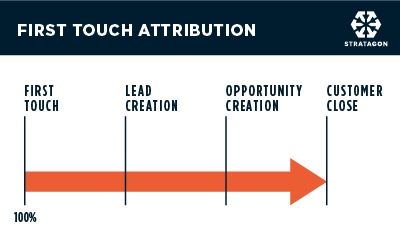
Last touch attribution: 100% of the “credit” goes to the last interaction
In the “last touch” attribution model, 100% of a deal’s revenue is attributed to the last interaction that occurred with a contact(s) before the deal closed. When you and your team are seeking to understand the value of efforts at the bottom of the sales funnel, pull a last-touch attribution model.
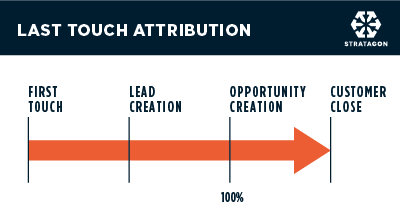
When the question, “What channel or asset is responsible for moving opportunities to closed deals?” is asked, a last-touch attribution report will provide great insight.
Linear attribution: “credit” is split equally across all interactions.
With a linear attribution model, deal revenue is spread equally across all interactions that occurred before the deal closed. With attribution divided equally, this model provides a fair look at all the touchpoints that lead to a deal closing. It’s important to note that if in reality, a specific touch point influenced a deal closing more than another, a linear model won’t show you that.
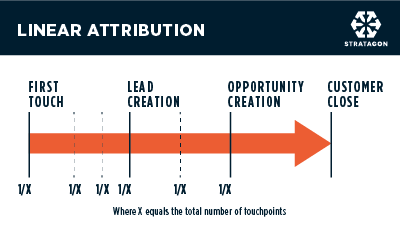 When questions like “what marketing efforts generally have the best ROI for my business?” are asked, a linear attribution model will create transparency.
When questions like “what marketing efforts generally have the best ROI for my business?” are asked, a linear attribution model will create transparency.
U-Shaped Attribution:
40% of the “credit” is given to the first interaction, 40% is given to the interaction that leads to lead creation, and 20% is split equally among all other interactions between first interaction and lead creation.
A U-shaped attribution model focuses on the top half of your funnel, giving priority to the interactions where your contacts first interacted with your business and where your contacts become leads in your CRM.
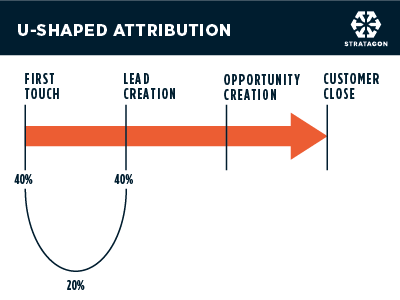 This model is best used when you want to understand what pieces of content in your campaign can be relied on for quality lead generation. When looking for answers to questions such as “Which rich content pieces drive the most revenue?” “Which CTA clicks generally lead to a lead being created?” or “Is a blog subscription a strong indicator of a quality lead?” turn to your U-shaped attribution model.
This model is best used when you want to understand what pieces of content in your campaign can be relied on for quality lead generation. When looking for answers to questions such as “Which rich content pieces drive the most revenue?” “Which CTA clicks generally lead to a lead being created?” or “Is a blog subscription a strong indicator of a quality lead?” turn to your U-shaped attribution model.
W-Shaped Attribution:
30% of the deal closing is attributed to the asset that led to the first interaction, 30% goes to the asset that led to lead creation, 30% to deal creation and the remaining 10% is split equally among all other interactions between first interaction and deal creation.
This model weighs almost entirely the first interaction, lead creation, and deal creation interactions. While it’s heavily focused on marketing efforts, it does give further insight into the handoff between marketing and sales with the inclusion of the opportunity creation stage.
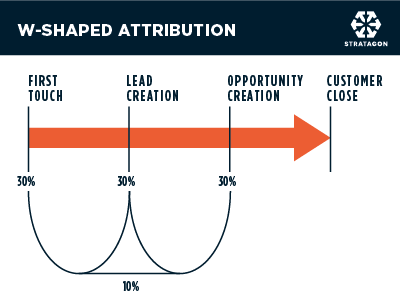
Generally, a W-shaped model is best for when e-commerce marketing teams are asking questions like “What marketing channels and assets are most valuable to me in trying to get customers to create a deal (or purchase) on my site?”.
Full-Path Attribution:
22.5% credit goes to the first interaction, 22.5% to lead creation, 22.5% to deal creation, 22.5% to the last interaction and the remaining 10% is split equally among remaining interactions.
As its name states, the “full path” attribution model distributes most of the revenue attribution equally among four major points of interaction or conversion. This model takes into account the steps in between deal creation and deal closing which is ideal for businesses with longer sales cycles.
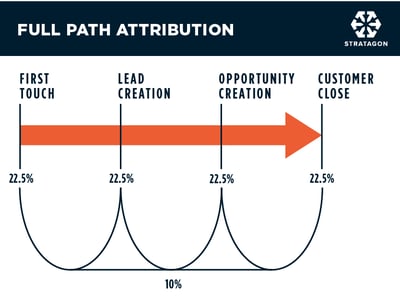 It is recommended that businesses looking to understand which pieces of content are generating the most revenue. Questions like “What is driving contacts to my site?” and “What is getting visitors to fill out forms and sign deals?” can be better answered with context from a full-path attribution model.
It is recommended that businesses looking to understand which pieces of content are generating the most revenue. Questions like “What is driving contacts to my site?” and “What is getting visitors to fill out forms and sign deals?” can be better answered with context from a full-path attribution model.
Time Decay:
Calculated with y=2^ (-x/7) where “y” is the time-decayed value of an isolated interaction, while x is the number of days before the conversion occurred. The 7 represents the half-life.
Yep, this is where the heavy math comes in. A time decay attribution model can accurately attribute credit to recent interactions. Through the model, heavy credit is given to interactions that happened closest to the conversion. Credit is distributed using a “7-day half-life” meaning an interaction that happened eight days before a conversion gets half as much credit as an interaction that happened one day before a conversion.
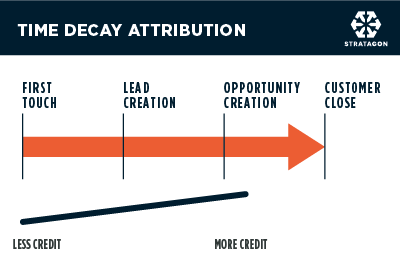 If your business’ success is dependent on relationship-building, a time decay attribution model can be helpful when trying to conceptualize attribution.
If your business’ success is dependent on relationship-building, a time decay attribution model can be helpful when trying to conceptualize attribution.
As I said, there is no single attribution model that will tell it all. Instead, use what you now know about these attribution models to decide which is best for your marketing strategy. If there’s one thing for sure, marketers have more attribution tools now than ever before.
Interested in learning more about the ins and outs of marketing attribution? Check out our blog, Marketing Attribution 101, to learn how you can start incorporating attribution into your marketing strategy.

